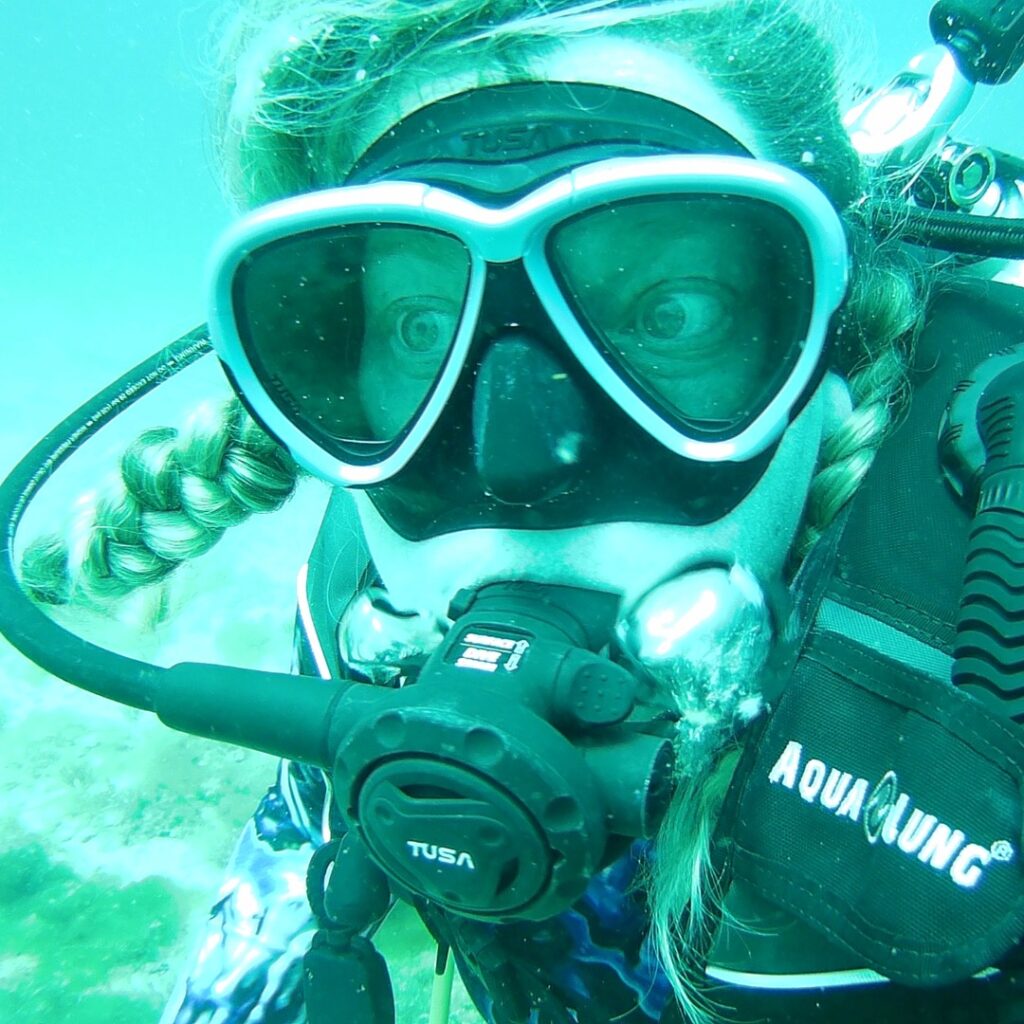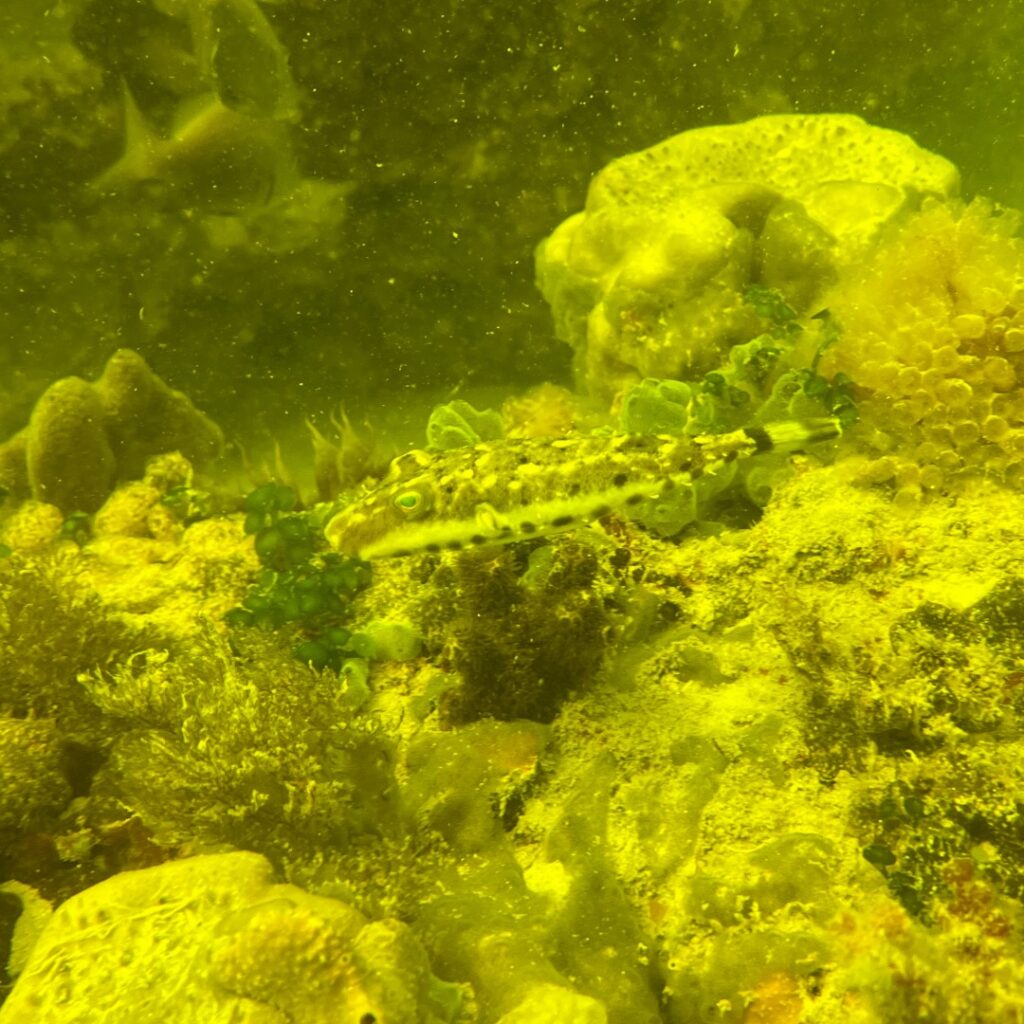April marks Participatory Science Month, also known as Citizen Science Month. Florida Sea Grant proudly celebrates the contributions of individual volunteers in coastal and marine research. Whether seasoned participants or newcomers, their efforts in monitoring coastal habitats or tracking wildlife have a profound impact on research and conservation efforts statewide.

Ruth McIlhenny has been a volunteer diver with the Artificial Reef Monitoring Program for six years. Image courtesy of Ruth McIlhenny.
During the bustling weekdays, Gainesville local Ruth McIlhenny serves as the strategic academic programs manager at the University of Florida Levin College of Law. However, when the weekend arrives, she swaps her office attire for a wetsuit and dives into the artificial reefs along the Gulf Coast. Ruth has actively participated in Taylor County’s Artificial Reef Monitoring Program for six years.
“My love is water. I enjoy swimming, diving, and snorkeling in the ocean and the springs. I’ve been diving since 1994, and I am a rescue diver,” says Ruth. “In 2018, I saw a social media post about an artificial reef research group in Taylor County that needed volunteer divers. Since I had never dived in the Gulf before, I saw this as a great opportunity to experience it!”
Florida Sea Grant supports the management, deployment, and monitoring of over 4,000 artificial reef deployments, which are used by 48% of Florida’s saltwater anglers targeting reef fish in the Gulf of Mexico. Since 2018, UF/IFAS Florida Sea Grant extension agent, Victor Blanco, has overseen the diving component of the Artificial Reef Monitoring Program in Taylor County. The program studies fish biodiversity around artificial reefs constructed from various structures and materials such as scrap metal, concrete,
Ruth serves as a buddy safety diver for the Artificial Reef Monitoring Program, accompanying Blanco during dives and capturing pictures and videos of fish and reefs. Ruth dives two to three times each season, refining her fish identification skills.
“It’s an incredible experience witnessing how the reefs change from year to year,” says Ruth. “I was thrilled to spot a six-foot goliath grouper at one of the reefs off Buckeye Reef, and a few weeks ago, during the first dive with artificial reefs at the Horseshoe Beach reef in Dixie County, I spotted my first batfish!”
Monitoring dives primarily take place in the reefs of Taylor County. However, following an agreement between Taylor and Dixie counties last year to enhance their monitoring, the program is now conducting dives in both counties this year.
In 2018, I saw a social media post about an artificial reef research group in Taylor County that needed volunteer divers. Since I had never dived in the Gulf before, I saw this as a great opportunity to experience it!
Ruth McIlhenny
Ruth’s commitment to the program stems from her desire to challenge herself and enhance her diving skills.

Pufferfish near Horseshoe Beach Artificial Reef. Image courtesy of Ruth McIlhenny.
“Diving can be challenging. Recently, I had to wear a wetsuit because the water was 66 degrees. With the added weight, climbing into a boat with four-foot wave swells was physically demanding. But I wanted to prove I could still do it,” says Ruth. “I’ve also had to work on my buoyancy since I am not naturally buoyant. Every dive I do makes me better and I learn patience.”
And though she has encountered some obstacles during her dives, she has found that every experience and friendly face is a meaningful encounter.
“I’ve valued all the friends I’ve made over the years. I’ve dived in Taylor County with the same people for three or four years. I’ve known Victor since 2018, and he’s been dedicated to making the program accessible to everyone, offering scuba diving training separately for youths and people with disabilities. I admire the passion shared by everyone involved. The shared love of the water and seeing all the exciting fish species makes these experiences unforgettable.”
Participating in the program has heightened Ruth’s sense of stewardship. She frequently cleans up fishing lines to prevent harm to marine life and has become more mindful of plastic usage. Though Ruth lives in Gainesville, her involvement in the program has also allowed her to recognize the importance of artificial reefs in Taylor County, informing charter captains and residents about the potential diving market in Taylor County.
“ I am happy to contribute to the program that can serve the environment and local communities. I know my strengths do not lie in the sciences, but I want to contribute to the greater good and scientific knowledge,” says Ruth. “We all start as beginners at some point, and it’s important to explore whether an opportunity is the right fit or not. Regardless of the outcome, the experiences are valuable. If it doesn’t work out, there’s always an opportunity to find a different path and contribute in meaningful ways, with any background or expertise.”